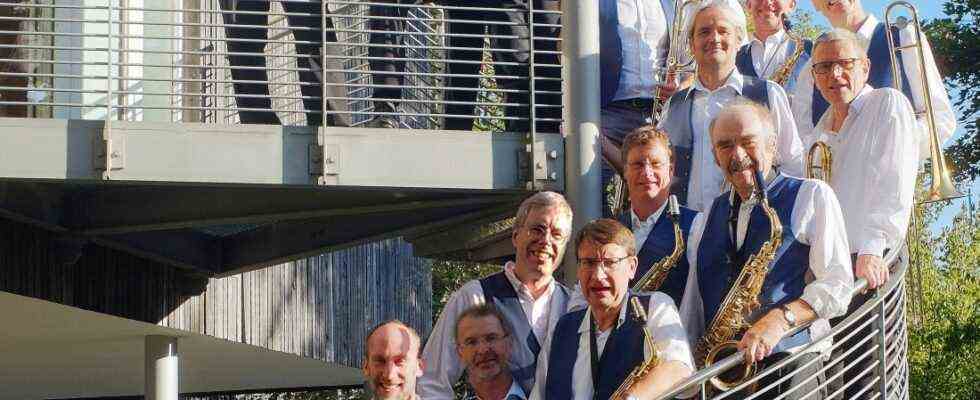When the red sun sinks into the forest near Linde, it gets cool in the practice room of the Linde Sound Machine. And so the baritone saxophonist Verena Bertold takes her thick jacket out of the car during a short break. Like the other musicians, it is here in the practice room. Because this big band with a full line-up of up to 22 people – whose name is derived from the employer of most of the musicians – practices on the seventh floor of a parking garage. It is on Wolfratshausener Strasse in Pullach. And there it pulls like pike soup, because the walls are open to the east and west. But that doesn’t take away any of its power from the heat of the sound. The combo, this time there are at least 13 musicians, has decided to drive a groovy piece of soul funk to perfection.
It takes less than ten bars to know: The days when the Linde Sound Machine used rather old-fashioned big band sounds with “Sunny Side of the Street” or “Autumn Leaves” are over. What goes on here under the tin roof of the parking garage, sparks and tears, as otherwise only from Pee Wee Ellis, Maceo Parker or the Phoenix Horns knows. Maybe not quite as perfect yet, but on the best way to get there.
And that now leads through the practice room. This room is, in this case, very special. While trombonist and founding member Andreas Kröner, like most of the gas engineers here, lectures the history of the band in the finest Swabian language and tells enthusiastically about the current singer Tamara Nüßl, a mezzo-soprano who was classically trained in Würzburg and has a penchant for funk, Auto turns around Car up the tight curves to the top level of the parking garage. Instruments are unpacked, assembled and tuned. Percussionist and drummer put their batteries on (and, like all percussionists and drummers in the world, immediately start drumming).
They meet every other Wednesday. Whoever has the time comes. Andreas Kröner says: “We are usually only complete when we have a gig.” He has a few cords with tied-in plastic scraps and lays them out on the floor. “That’s for the distance rules.” Up here? Almost outdoors? Where the rain sometimes drums so loudly on the corrugated iron roof that even sax and trumpets hardly stand a chance? But better safe than sorry, the virus shouldn’t stand a chance even with the hottest music.
The gas-powered sound machine wants to keep working
This Linde orchestra has been around since 2003. It was one of the engineers, Ricardo Ribeiro, who, after various inquiries and advances from music-experienced Lindeans, proclaimed the foundation of the Sound Machine. Count Basie, Glenn Miller or Duke Ellington were the names of the composers of the first era. They played at in-house birthday or anniversary celebrations, and a first real gig then took place in the Geltinger ambush. Forst Kasten became a fixed annual program, which unfortunately is a thing of the past due to the closure of the company; Performances such as the city festival in Dresden or the gala for 100 years of Linde Gas in Linz and Munich were real highlights. The ten-year-old was celebrated with a sold-out house in the Loisachhalle in Wolfratshausen. Unfortunately the bandleader died in 2015, a compilation of the Sound Machine under his direction can be found online. The impression: old-fashioned, but highly professional.
The shock was great, the cut deep. But the gas-powered sound machine wanted to continue. And looked for a new boss. She found that in Holger Bischof, and with him a completely new groove came into the house, or into the upper floor of the park. Today the numbers are called “Slo Funk” (in the original movement by Bob Mintzer) and “Come On Come Over” by the crazy radio bassist Jaco Pastorius.
This is the world of Holger Bischof. And that’s why he’s well known in the Munich wind scene. He blew and still blows the saxophones (preferably the alto) in various combos from jazz to funk and soul and is of the professionalism that allows you to play even the most elaborate arrangements with the most complicated breaks from sight. So he stands in front of the 13 musicians who are ready to practice (two of them are musicians), the setting sun behind him, and counts in. “One two, three …” The whole body is rhythm. And the combo, saxophones, trumpets, trombones, a clarinet, a bass, a percussionist and a very discreet drummer follow him through the jungle of notes. And then it’s the turn of the individual instrumental groups. This is precision work.
Siemens has a similar big band, BMW has a chamber orchestra
Perhaps it is the fascination of orchestral playing that bands like the Linde Sound Machine come together. And that they have the company logo of their employer in their title, so to speak, speaks for a certain corporate identity. Siemens, for example, has a very similar big band in Berlin, and BMW even has a classic chamber orchestra. And a note on the side: at the Süddeutsche Zeitung Deadline, the editorial band, regularly on Tollwood for Organized Noise.
So it’s no wonder that here in Lindeparkhaus II, even after an hour of hard work, there is still maximum concentration. They actually wanted to perform in November now, nothing big, an in-house party. But unfortunately it was canceled. Because of Corona.
But the current situation gives them a little hope, which gives the impression that the pandemic may soon be a thing of the past. And where there is hope, there is practice. Regardless of whether the wind is blowing or the rain is making a noise. “There was a thunderstorm once. We relied on this to look like a Faraday cage,” says the engineer. On the part of the Linde Sound Machine, you just want to be ready at all times with a hot heart and hot sound.

